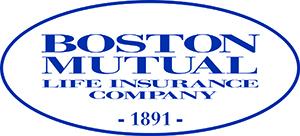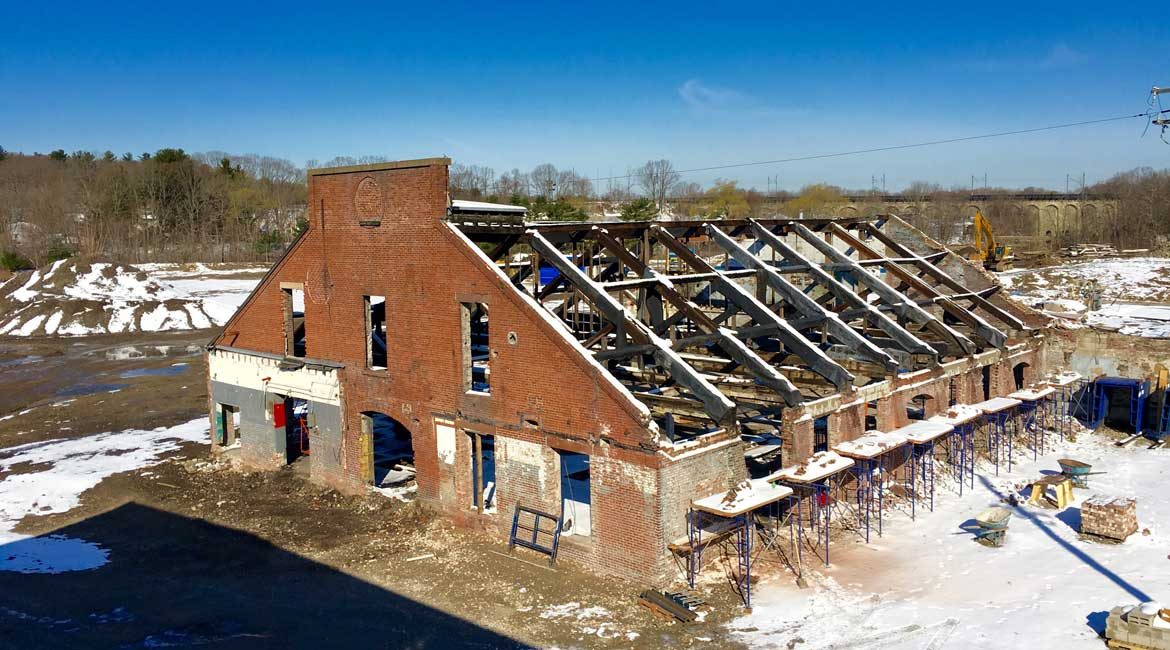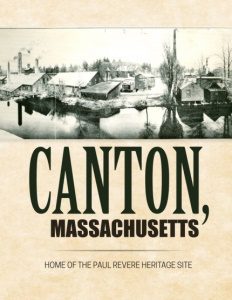Business View Magazine interviews representatives of the Paul Revere Heritage Commission as part of our focus on Massachusetts Cities Economic Development.
For most Americans, the name Paul Revere conjures up images of the Boston silversmith’s famous “midnight ride” of April 18th, 1775, when he galloped through the towns of Middlesex County, Massachusetts to warn the colonists of the British troops who were crossing the Charles River from Boston on their way to Lexington and Concord to seize a rebel arms cache, and perhaps, arrest a few of the nascent revolution’s leaders.
But for the residents of Canton, Massachusetts, a town of 21,500, some 15 miles southwest of downtown Boston, the story of Paul Revere begins much later in the life of the famous patriot – in fact a good quarter century after his famous ride. In 1801, at age 65, Revere decided to move from Boston to Canton to set up a mill to roll copper sheets, presumably to replace corrosive iron fixtures and plate bottoms on ships with rustproof copper. The process of plating ship bottoms, referred to as “sheathing” or “coppering”, helped increase the speed and lifespan of ships. Copper, specifically, was desired for this process due to the fact that it reacts with seawater to create an oxide coating that prevents the build-up of barnacles, weeds, and other detritus, in addition to physically stopping worms from burrowing into and degrading the wood.
But even though Revere had earned a comfortable living as a silver and goldsmith, and later as an the owner and operator of a iron and brass foundry, this new copper venture involved considerable financial risk, as his copper rolling process was still in the development stage and he hadn’t yet secured the rights to use the waters of the nearby Neponset River to power his factory. Luckily, in addition to his own investment of $25,000, the U.S. government loaned Revere another $10,000 as well as 19,000 tons of copper to start his new Canton firm, and with the water power issue resolved, within a few years, the Boston artist, industrialist, and patriot became the first American to successfully roll copper into sheets in a commercially viable manner.
Revere landed his first major contract in 1802 – an order for 6,000 feet of copper sheathing to cover the dome of the relatively new State House in Boston. A year later, the company was commissioned to provide copper sheathing to protect the hull of the U.S.S. Constitution or “Old Ironsides.” In subsequent years, Revere’s company manufactured copper boilers for Robert Fulton’s early experimental steamships, turned out muskets and brass cannons for the War of 1812, and manufactured the copper dome of the New York City Hall.
In 1804, son, Joseph Warren Revere, moved the family’s bell-making foundry to Canton from Boston, after a great gale blew its roof off, there. In addition to copper rolling, the Reveres continued to manufacture hundreds of their famous, cast-iron church bells in Canton until the middle of the 19th century. Revere also established a second home on the factory site, spending the summers in Canton, where he and his descendants played an important role in the town’s political, social, and economic life.
In 1909, the Revere foundry was bought by the Plymouth Rubber Company, which owned it until 2006. “When they left, it was a very large parcel of contaminated industrial land,” says Laura Smead, Canton’s Town Planner, “but it still had this historic rolling mill on the site, and a barn that was used by Paul Revere. Including all of the land, and water, and wetlands, it’s about 40 acres of which maybe 27-30 are actually buildable. It’s right near the center of town, close to our main street.”
For the last ten years, the Town of Canton has been negotiating with the property’s current owner in order to remediate and redevelop the Paul Revere Mill/Plymouth Rubber Company property. “Over those ten years, there were a number of town meetings, and a number of other meetings before the Board of Selectmen and the Planning Board, to rezone the property and get some sort of development to clean it up,” says Jeremy Comeau, a member of the town’s Paul Revere Heritage Commission and former Planning Board member of 15 years. “Finally, in 2015, the Board of Selectmen, the Planning Board, and some other town officials, got together with the developer, and got a project approved by town meeting.”
Victor Del Vecchio, a member of the Paul Revere Heritage Commission, and former Board of Selectmen member of 15 years elaborates: “It was a great collaborative effort. The negotiations started in 2014 and lasted for nearly a year and resulted in a very comprehensive agreement,” he reports. “Now, understand that this site was largely a contaminated wasteland. It had been used, over the years, for a variety of industrial purposes and, in fact, as part of the development agreement, over 6.3 million dollars will be dedicated to the special demolition and environmental cleanup of the site. So, the effort, which took many, many hours, included the support of the Board of Selectmen, the Planning Board, the Conservation Commission, the Board of Health, the Board of Assessors, the Historical Commission, the Parks and Recreation Department, the Police and Fire Chiefs, the School Committee, and other groups – which is why it passed nearly unanimously at the special town meeting.”
The final agreement between the town and the developer splits the property into two pieces: a public parcel and a private one. Plans for the nine-acre, public parcel include open space and the rebuilding of the rolling copper mill to become a Paul Revere Museum and Cultural Center, and his son’s old barn to be transformed into a historic-themed restaurant/tavern. “The town already has a very nice Main Street/town center that you can walk to from the site, but what it’s lacking is open space,” says Smead.
The availability of both open space and the funding mechanism to buy it, was fortuitous, as Comeau explains: “A number of years ago, the town voted in favor of the Community Preservation Act and we set aside a certain percentage each year, and the state gives the town funds for that. And so, part of this project probably wouldn’t have happened if not for using Community Preservation funds to purchase a large portion of land to be set aside just for open space. And so, this is probably the first time in quite some time, if ever, that the town will have a town green or town common.”
“We have a revitalized downtown,” agrees Del Vecchio. “It’s a quite attractive core of our community, but this complements that; it’s walking distance to it and it provides nine acres of open space with these two historic buildings, which we think will be a magnet for additional folks coming to town, to spend time in Canton, see what Canton’s history is about with respect to Paul Revere, have lunch or dinner, and go home. The whole effort regarding the repurposing of the Paul Revere buildings contemplates dedicating the life story of Paul Revere – his family, his company, the birth of the copper industry – Paul Revere’s life and times in Canton.” “We are in the middle of completing a market feasibility analysis and business plan related to those historic buildings to make sure all the numbers work, and so far it looks very promising,” Smead adds.
Plans for the private parcel include 272 units of housing, including 186 owner-occupied condominiums and 60 age-restricted rental apartments. “The initial proposal was about 500 or 600 apartments and the town absolutely could not handle that,” Comeau avers. “So, over the years, the town was able to negotiate down to this 272, with 60 units that are over-fifty-five rentals, which is really important to the community because a lot of people are getting a bit older in the community and want to utilize the option at a place where their backyard is going to be this gorgeous field, the town commons, plus these two historic buildings. So, this will be a prime location for those who want to move there.”
“As the Town Planner, what I like about it from a ‘best practice and sustainability’ perspective is having this relatively denser development, but it’s done in conjunction with trails and open space. It’s also within walking distance to a couple of commuter stations. So, you have this transit-oriented development which reduces some of the burden on the local roads.”
“This is a perfect example of smart growth,” echoes Del Vecchio. “It’s literally next to the commuter station called Canton Junction. So, people can walk to and from the train station to go into Boston or Attleboro, or wherever they want, and then come home and walk to their residence. It’s a great location. It’s also bordered by bodies of water, so it’s a pretty location.”
It’s expected that housing construction will take several years. “The last two years, they’ve been cleaning up the site,” Del Vecchio says. “There’s a significant amount of environmental damage to the land, which is being remediated – that’s under way. It was spotted with a number of industrial buildings – it was the ugliest thing you’d ever want to look at – and that had to all be demolished in a safe and reasonable fashion. So that’s been completed. In addition, there was a variety of permitting steps that have to be taken, including the Conservation Commission and the ZBA (Zoning Board of Appeals), and the Board of Health and the Department of Environmental Protection, so that process is taking some time, and in fact, is continuing. So, they haven’t yet broken ground in terms of actually constructing their first unit. The first housing units probably will be available beginning in 2018 and then, thereafter, it will occur more rapidly, but I would guess it will take three to five years.”
Even so, after years of negotiating, the folks in Canton are beginning to see and appreciate the early fruits of their labors. “This is a home run,” says Del Vecchio. “It had the support of so many boards and commissions, because there’s a little bit of something for everyone, including the schools. As part of the development agreement that was negotiated with the developer to allow it to rezone the remaining portion of about 30 acres, they agreed to an arrangement under state law, called a District Improvement Financing Plan. It allows the use of tax revenues specific to the project that would not otherwise have existed, to be funneled back into the site for various infrastructure improvements, such as repurposing the two buildings, which is going to be a significant undertaking. And it also allows us to provide some capital to the schools so that they can use that for various capital improvements. There are two million dollars set aside in the development agreement, funded from this District Improvement Financing arrangement, again, coming from the taxes of the developer, to permit the schools to use it as best they see fit.”
“This was an amazing exercise in the town’s boards and citizens and interested parties coming together for an important project,” says Comeau. “The negotiations were long, but if it weren’t for all of these groups coming together, I don’t think it would have passed town meeting. It failed about three other times previous to this. It was an exercise in the way a town should work together and I think it shows that our community is committed to right development but also to the historic nature of our town.”
Del Vecchio says, “In Canton, we don’t participate in government in a partisan fashion at all. In my fifteen years of being on the Board of Selectmen and seven years prior to that on the Planning Board, I have never been involved in a project of this magnitude with this much cohesion and unity. This is a wonderful example of where governance works. And that’s what I’m most proud of. Yes, I’m equally pleased that we finally attracted the attention and the interest to clean up a hazardous waste site, but I’m more impressed by the fact that this was done by so many different people and groups.”
Town Planner Smead sums up: “The redevelopment of this site checks all the boxes in terms of smart growth, in terms of historic preservation, in terms of affordable housing, and in terms of creating a healthy, vibrant, place-making opportunity.”
For the town of Canton, Massachusetts, Paul Revere is not just a character in the Longfellow poem that every school child in America has heard or memorized. He is a living, breathing presence, and soon to be further memorialized with the establishment of the long-awaited, Paul Revere Heritage Site.
AT A GLANCE
WHO: Canton, Massachusetts
WHAT: A town of 21,000
WHERE: 15 miles southwest of Boston
WEBSITE: www.town.canton.ma.us
PREFERRED VENDORS

Boston Mutual Life Insurance – Founded in 1891, and headquartered in Canton, MA, Boston Mutual Life Insurance offers a wide range of worksite, group, and individual insurance programs nationwide, including life insurance, disability insurance, accident insurance, and critical illness insurance. –www.bostonmutual.com
DIG DIGITAL?

May, 2017 Issue


